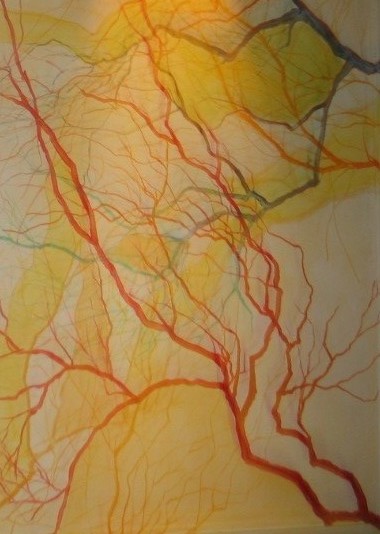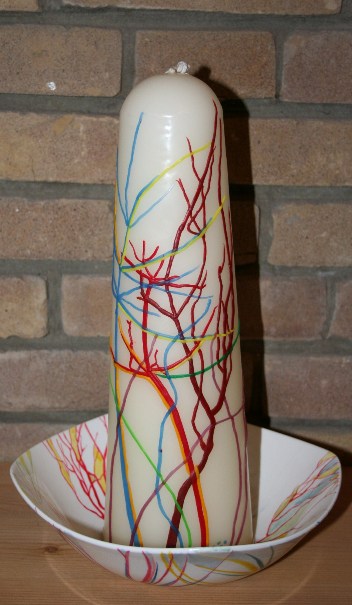New memorial Places in Dutch Churches- M Hengelaar
New Memorial Places in Churches in The Netherlands

Memorial Places: Experience of Solidarity
by Marleen Hengelaar-Rookmaaker
For Christian congregations commemoration is a core activity. We remember God’s great deeds in history, in our own lives and the lives of our loved ones in the same way that God remembers us and all who have gone before us. He does not forget us. He holds our memory dear. Our names are written in the palm of his hand.
Traditionally the church has always devoted much space to the remembrance of the dead and this not only in words and rituals, but also literally by giving graves, plaques and shields of mourning and memorial chapels a place within the walls of the church building. In this way the deceased rested in the midst of the congregation in the house of God, the place where Jesus’ death and resurrection are made manifest in word and sacrament. The faithful knew themselves surrounded by their spiritual ancestry, with whom they were connected as a link in a long procession on its way to God’s future.
In the 18th century burials in churches were forbidden in the Netherlands. For a long time there was very little attention for the remembrance of the dead in the Reformed tradition. In Catholic churches there was more room for this in the form of special masses dedicated to a dear loved one, feasts like All Saints and All Souls, and memorial chapels to pray and burn a candle.
In the Netherlands in the past century Protestant voices made themselves heard to make more room for the remembrance of the dead. In many Reformed churches a special Sunday is now devoted to this. Also places of remembrance have sprung up within church buildings, especially after the year 2000. They are positioned to the right of the liturgical centre in the front of the church or along one of the side walls. Here one can withdraw to be quiet in God’s presence. In these places of grief and comfort candles burn softly, a Bible and a book to write down thoughts and requests for prayer lie on the table. There are stones or small crosses with the names of the deceased written upon it. Sometimes symbols of life and death have been incorporated. The place is located underneath a stained-glass window or a painting. A sculpture or well-designed candleholder stand on the floor or table.
In the Catholic tradition memorial places have always been present. In 2007 the Catholic Naaldkerk in Santpoort-Noord decided to transform two old confessional boxes into a baptismal chapel and a memorial chapel. Artist Ria Schoof was asked to realize this.

In the baptismal chapel Ria Schoof worked with the theme of water. Everything flows, streams and bubbles with life. This in contrast to the memorial chapel opposite to it, where rest and harmony reign. On the shells, attached to a blue or pink ribbon, the names of the recently baptized children are written. After a year the shells are removed and given to the parents.
 |
 |
 |
In the memorial chapel the theme is ‘branches that reach into the sky’. The wooden crosses on which the names of the deceased are painted, have been hung invisibly so that they seem to float in the air. Here an atmosphere of contemplation and serenity prevails through the use of warm autumnal colours. The mural has its starting point in the central white cross on the wall and continues on the ceiling, where the branches transform into delicate veins. The matching candles and candlesticks were also designed and made by Ria Schoof. Through the stained-glass windows we see the branches moving hesitantly towards each other. Here inside and outside, life and death, come together.
*******
Ria Schoof: Memorial Chapel in the Naaldkerk (Our Lady of Perpetual Help) in Santpoort-Noord, The Netherlands, 2007.
Ria Schoof was raised in a Catholic family. She studied at the RietveldAcademy in Amsterdam. In addition to paintings and murals she paints glass, metal and ceramics. The latter she also makes herself. Ria has illustrated books, works with fabrics and has also mastered old decoration techniques like marbling and the decoration of candles. She has designed several centres for silence and a room of mourning, besides various commissions for churches. For more, see http://www.riaschoof.nl
Marleen Hengelaar-Rookmaaker is Editor-in-Chief of ArtWay. At the moment she is working on a Handbook for Art in the Church together with Aniko Ouweneel-Toth.
ArtWay Visual Meditation November 2, 2014


